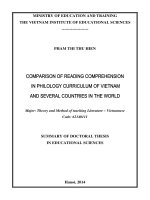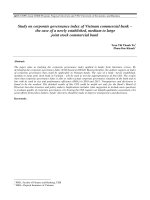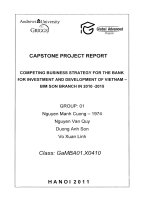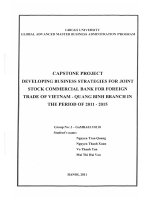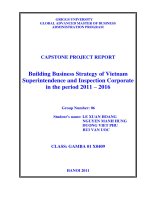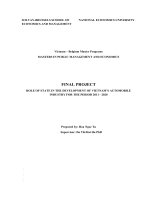Introgression of the Saltol into AS996, the elite variety of Vietnam, using Marker Assisted Backcrossing
Bạn đang xem bản rút gọn của tài liệu. Xem và tải ngay bản đầy đủ của tài liệu tại đây (1.1 MB, 10 trang )
VNU Journal of Science, Natural Sciences and Technology 28 (2012) 37-46
37
Introgression of the Saltol into AS996, the elite variety of
Vietnam, using Marker Assisted Backcrossing
Luu Thi Ngoc Huyen
1,
*, Luu Minh Cuc
1
, Abdelbagi M. Ismail
2
, Le Huy Ham
1
1
Agricultural Genetics Institute; Vietnam Academy of Agricultural Sciences
2
International Rice Research Institute - DAPO Box 7777, Metro Manila, Philippine
Received 09 January 2012
Abstract. This study focus on developing new salinity tolerance and high yielding rice lines, using
markers assisted backrossing (MABC) as a technological tool for breeding. Total of 500 SSR
markers on 12 rice chromosomes were screened for parental polymorphic markers. Of which, 52
primers in the Saltol region were examined with the two parents varieties to identify polymorphic
primers for screening the Saltol region of the breeding populations. An analysis of 63 SSR markers
on approx. 500 plants for each backcross generation of ASS996/FL478 for three steps selection.
The two BC
1
F
1
plants P284 and P307 which had the highest recipient alleles up to 89.06% and
86.36%, were chosen for the next backcrossing. Three BC
2
F
1
plants with the recipient alleles up to
94,03 and 93,18% were used to develop BC
3
F
1
generation. The best BC
3
F
1
plant was P284-112-
209 with all the recipient alleles and Saltol region. The four plants P307-305- 21, P284-112-195,
P284-112-198, P284-112-213 were the second ranking with only one locus heterozygous (applied
63 markers covere on 12 chromosomes). These five plants were chosen as the breeding lines as the
result of Saltol-AS996 introgression. The breeding line BC
4
F
1
having 100% genetic background of
donor variety is ready for develop new salinity tolerant variety ASS996-Saltol to cope with climate
change.
Keywords: AS996, marker assisted backcrossing, rice, Saltol, QTL.
1. Introduction
∗
∗∗
∗
Rice is the most important food source for
half of the world’s population and also the
main staple food for most of the country's 86
millions people. Vietnam is the world's second-
largest rice exporter, along with the top exporter
Thailand, both counted for 50 percent of the
world rice trade. Developing adaptation rice
varieties to cope with climate change and sea
_______
∗
Corresponding author. Tel: 84-4-37544712.
E-mail:
level rise for the Red River Delta and Mekong
River Delta is crucial to Vietnam economy and
food security, it also contributes to the global
food security.
Research at IRRI resulted in the
development of high yielding rice varieties
tolerant of abiotic stresses such as submergence
and salt stress, and these varieties can help the
unfavorable coastal areas less vulnerable to
climate change impacts [1]. These improved
varieties were developed using both
conventional and modern breeding methods.
L.T.N. Huyen et al. / VNU Journal of Science, Natural Sciences and Technology 28 (2012) 37-46
38
Breakthroughs in salinity tolerance breeding
became feasible after the identification of major
chromosomal regions (Quantitative trait loci,
QTLs) underlining salinity (Saltol) stresses, and
the development and use of a marker system for
their speedy incorporation into modern high
yielding and popular varieties through marker
assisted backcrossing (MABC) [1]. The
foundation of MABC strategy is to transfer a
gene/QTL from a donor line to a recipient line
while selecting against donor introgressions
across the retained genome [2, 3, 1]. MABC
breeding strategy was applied for developing
new salt tolerance Vietnam’s varieties.
2. Materials and Methods
2.1. Plant materials and crossing scheme
- FL478 was used as the donor of Saltol.
The recipient variety was AS996, which is
widely grown cultivars in the South of
Vietnam. For the MABC breeding strategy,
AS996 was crossed with FL478 to obtain F1
seeds. F1 was backcrossed to AS996 to
obtained a large number of BC
1
F
1
. Total 573
BC
1
F
1
plants were screened for foreground,
recombinant and background selections. The
plants carrying target QTLs and the biggest
recepient genom were selected for the next BC
generation. Over five hundreds BC
2
F
1
and then
371 BC
3
F
1
plants were screened for foreground,
recombinant and background selections. The
BC
2
F
2
or BC
3
F
1
individuals carrying target
genes and almost recepient genom were
obtained.
2.2. Parents SSR polymorphism screening
Approx. 500 SSR markers distributed in the
12 chromosomes including foreground,
recombinant and background markers were
screened.
2.3. Genotype data analyses
Genotype data anlyses were obtained by
analyzing DNA with SSR markers using 15 µL
PCR reactions on 96-well plates. After initial
denaturation for 4 min at 94
0
C each cycle
comprised 1 min denaturation at 94
0
C, 1 min
annealing at 55
0
C, and 1 min extension at 72
0
C
with a final extension for 5 min at 72
0
C at the
end of 30 cycles (Eppendoft thermal cyclers).
The PCR products were mixed with
bromophenol blue gel loading dye and were
analyzed by electrophoresis on 4.5%
acrylamide gel at 1500V (Biorad system)
followed by silver stainning steps and scoring;
or electrophoresis on 6% -8% acrylamide gels
at 100v (Dual Triple-Wide Mini-Vertical
System, C.B.S.Scientific, CA, USA) followed
by SYBR-Safe staining (Invitrogen), gel
documentation (Alpha Innotech), and manual
scoring of the gel pictures.
2.4. Data analyses
The molecular weights of the different
alleles were scored using Alpha Ease Fc 5.0
software. The marker data was analyzed using
the software Graphical Genotyper (GGT 2.0)
[4]. The homozygous recipient allele,
homozygous dominant allele and heterozygous
allele were scored as ‘A’, ‘B’ and ‘H’. The
percent markers homozygous for recipient
parent (%A) and the percent recipient alleles
including heterozygous plants (%R) were
calculated.
2.5. Evaluation of salinity tolerance
Pre-germinated BC
2
F
2
and BC
3
F
1
seeds
were sown in holes on styrofoam floats with a
L.T.N. Huyen et al. / VNU Journal of Science, Natural Sciences and Technology 28 (2012) 37-46
39
net bottom suspended on trays filled with
Yoshida nutrient solution [5]. Three
replications were used for each experiment,
with nine individual plants per line evaluated
for each replication. Salt stress was imposed 14
days after germination by adding NaCl to an
EC of 12 dS m−1 in Yoshida nutrient solution
until final scoring. IR29 (sensitive) and FL478
(highly tolerant) were used as checks. The pH
of the nutrient solution was adjusted daily to
5.0, and the culture solutions were replaced
every 5 days. Entries were scored based on
visual symptoms using IRRI’s Standard
Evaluating Score (SES) for rice, with ratings
from 1 (highly tolerant) to 9 (highly sensitive) [6].
3. Results and discussion
3.1. Parental SSR polymorphism screening
A number of about 500 SSR markers on 12
rice chromosomes were screened for parental
polymorphic markers for all foreground,
recombinant and background analyses. Of the
500 SSR markers, 52 primers in the Saltol
region were checked with the two parental
varieties to find out more polymorphic primers
to use for screening the Saltol region of the
populations.
Total 63 polymorphic primers for the cross
AS996/FL478 were identified. The result
showed that frequence SSR markers for DNA
polymorphisms between parental AS996/FL478
was very low. All those markers were used for
screening the BC
1
F
1
, BC
2
F
1
and BC
3
F
1
generations.
3.2. Genotyping
3.2.1 . Genotyping BC
1
F
1
We have already applying MABC on
foreground selection, recombinant selection
folowed by background selection. MABC is a
precise and effective method to introgress a
single locus controlling a trait of interest while
retaining the essential characteristics of the
recurrent parent [2]. MABC has three main
advantages over conventional backcrossing.
Firstly, DNA markers can be used for simple
and efficient selection of the target locus
(‘foreground selection’). Secondly, the size of
the donor chromosome segment containing the
target locus can be minimized (‘recombinant
selection’). Thirdly, the recovery of the
recurrent parent can be accelerated by selecting
backcross lines with a higher proportion of
recurrent parent genome (‘background selection’).
Saltol is a major QTL associated with the
Na–K ratio and seedling-stage salinity
L.T.N. Huyen et al. / VNU Journal of Science, Natural Sciences and Technology 28 (2012) 37-46
40
tolerance, was identified on chromosome 1.
This QTL was tested in a hydroponic screen at
the seedling stage revealed that this QTL
explained 43% of the variation for seedling
shoot Na–K ratio in the population [7]. One
highly salt tolerant RIL from this population,
FL478 (IR 66946-3R-178-1-1), has been
promoted as an improved donor for breeding
programs, as it has a high level of seedling
stage salinity tolerance and is photoperiod
insensitive, shorter and flowers earlier than the
original Pokkali landrace.
Figure 2. Physical map of Salton region 11.1-11.6Mb on chr.1.
Several global gene expression profiling
studies have investigated transcriptional
differences between the susceptible IR29
compared with FL478, revealing the up-
regulation of genes in FL478 under salt stress
for ion transport and cell wallrelated genes [8,
9], while differential expression was observed
in roots for cation transport proteins [10] and
kinases and phosphatases [11]. Furthermore, an
analysis of single feature polymorphism in the
Saltol region suggested that FL478 contained a
DNA fragment smaller than 1 Mb from Pokkali
at 10.6–11.5 Mb on chromosome 1, flanked by
IR29 alleles [12]. In 2010, based on result from
IRRI scientist, more STS markers were
developed for used in MABC. The physical
map of Saltol region was shown in figure 2.
Based on the map of Saltol QTL region, the
best markers within the Saltol QTL region were
AP3206 and RM3412, the most useful markers
flanking the Saltol region were RM10694
(telomeric to Saltol) and RM493 and RM10793
(centromeric to Saltol), while nearby markers
that can be used for negative selection are
RM490 above Saltol and RM7075 below.
Microsatellite markers unlinked to Saltol
covering all the chromosomes, that were
polymorphic between the two parents, were
used for recombinant and background selection
to recover the recipient genome. Among 500
SSR primers surveyed, 42 markers were
analysed for selection initially on BC1F1
individuals. For foreground selection, AP3206,
RM3412 and RM10793 were used for
screening heterozygous plants. After that step,
another flanking markers were used to
identified the recombinant plants.
L.T.N. Huyen et al. / VNU Journal of Science, Natural Sciences and Technology 28 (2012) 37-46
41
Figure 3. Screening individuals on crossed BC
1
F
1
(AS996/FL478) using primer AP3206.
Lane 1: 25bp marker, 2-25 and 26-47: BC
1
F
1
in dividuals, Lane 48:AS996, Lane 49: FL478
Figure 4. Screening individuals on crossed BC
1
F
1
(AS996/FL478) using primer RM310.
Lanes 26, 51: 25bp marker, 2-25 and 27-48: BC
1
F
1
in dividuals, lane 49:AS996, lane 50: FL478
In table 1 was the recipient allele of the
twelves BC
1
F
1
recombinant individuals, the
percent markers homozygous for recipient
parent was “A%”, the percent markers
heterozygous was “H%’ and the percent
recipient alleles including heterozygous plants
was “R%’.
Table 1. The recippient allele of the twelves BC
1
F
1
recombinant plants
Plant number
65 149 228 238 281
284
305
307
311 401
411
426
A % 55.26 51.43 60.53 44.74 56.25
78.13
66.67
75.76
63.64 73.68
66.67
63.64
H % 34.38 37.93 36.36 34.38 15.63
21.88
33.33
21.21
36.36 0.00
33.33
36.36
R % 72.45 70.39 78.71 61.92 64.06
89.06
83.33
86.36
81.82 73.68
83.33
81.82
Total of 12 recombinant plants were used
for background selection. Two plants P284 and
P307 having the highest recipient alleles up to
89.06 and 86.36% were used to develop BC
2
F
1
populations. In case the ordinary breeding was
applied, frequency of recipient genome was
only 75% in the BC
1
F
1
, lower than in this study
11-14%.
3.2.2 .Genotyping BC
2
F
1
Approx. five hundred BC
2
F
1
individuals of
the cross (AS996xFL478) were grown and
analysed. The same procedures were applied to
screen the foreground selection again with
AP3206, RM3412, RM10793, RM10711. The
recombinant selection was done with
RM10694,RM562, RM7075 along the Saltol
region on chromosome 1. From 250
heterozygous plants, 26 recombinant plants
were identified.
1 2 25
AS FL
1
26
L.T.N. Huyen et al. / VNU Journal of Science, Natural Sciences and Technology 28 (2012) 37-46
42
Figure 5. BC
2
F
1
(AS996xFL478) individuals screening using primer RM10793 - left, and RM10711- right.
For background selection, the primers
shown heterozygous DNA bands from previous
generation with 10 more additional primers
were used. Plant P307-322, P284-112 and
P307-305 were the best plants with the recipient
alleles up to 93,18% and 94,03% respectively.
These three plants were used to cross with
recipient variety for BC
3
F
1
generation. In each
individuals, half of the tillers were used for
BC
3
F
1
crossing, the others were used for BC
2
F
2
selfing. In the case where the ordinary breeding
was applied, frequency of receipient genome
was only 87,5% in the BC
1
F
1
, but in here, the
best plants were selected with the recipient
alleles about 5,7- 6,5% higher than those of
conventional method.
3.2.3. Genotyping BC
3
F
1
From the above results, three populations
from three plants were analysed. Total of 371
plants were screened for the four markers
located in the Saltol region. Only 94 plants
were used for recombinant selection. In
background selection, 25 primers were used. In
figure 6 was the graphical of 14 BC
3
F
1
individuals, which was given by GGT2.0
software.
Figure 6. Graphical of the 14 recombinant BC
3
F
1
plants using GGT2.0 software.
Plant P284-112-209 was the best BC
3
F
1
individual with all the recipient alleles screened
based on total of 63 markers (figure 7). The
four plants P307-305- 21, P284-112-195, P284-
112-198, P284-112-213 were the second
ranking with only one loci heterozygous. All
those 5 plants were chosen as the breeding lines
for result of Saltol-AS996 introgression.
L.T.N. Huyen et al. / VNU Journal of Science, Natural Sciences and Technology 28 (2012) 37-46
43
Figure 7. Graphical of the best BC
3
F
1
plant P284-112-209 using GGT2.0 software.
3.2.4. Evaluation of salinity tolerance
As described in the part of method, BC
2
F
2
and BC
3
F
1
seeds were screening to evaluate the
introgression of Saltol fragment into AS996.
Salt stress was imposed 14 days after
germination by adding NaCl to an EC of 12 dS
m
−1 in Yoshida nutrient solution until final
scoring. Based on visual symptoms using
IRRI’s SES for rice, when the suceptible
variety IR29 (sensitive) scored 9 and variety
FL478 were used as highly tolerant checks
scored 3, all the BC
2
F
2
of the selected plants
P284-112, P307-305 and P307-322 having the
same score as the tolerant checks. It means that
the homozygous Saltol fragment working well
in BC2F2 generation. The BC3F1 plants scored
3-5 because of the heterozygous of Saltol
fragment.
The original IR29/Pokkali QTL study using
80 extreme RILs identified Saltol as the QTL
with the highest significance for shoot Na–K
ratio with an LOD of 14.5 and R2 of 64%,
based on selective genotyping [13]. A follow-
up study categorized the RILs into sensitive and
tolerant groups and mapped the position of
Saltol between RM23 and RM140 (10.7–12.2
Mb on chromosome 1), and confirmed the
effect of the shoot Na–K ratio with an LOD of
6.6 and R2 of 43% using 54 RILs [7]. While
neither of these studies presented the percent
variation explained for visual SES. tolerance
scores or survival, it was assumed that by
controlling the key mechanism of Na+/K+
homeostasis under stress, Saltol is a major
contributor to seedling stage tolerance. The data
L.T.N. Huyen et al. / VNU Journal of Science, Natural Sciences and Technology 28 (2012) 37-46
44
from the current study confirmed that Saltol
contributes to Na+/K+ homeostasis with an
LOD of 7.6 and R2 of 27% across the 140 RILs
and a 30% decrease in the shoot Na–K ratio,
from 1.7 to 1.2 in the IR29/Pokkali backcross
lines, while the Saltol effect on SES scores in
the QTL population and backcross lines was
much smaller. The fact that Saltol affected the
Na–K ratio more than other traits supports the
possibility that the sodium transporter SKC1
gene underlying the Saltol QTL [8]. SKC1 was
found to encode a sodium transporter that helps
control Na+/K+ homeostasis through unloading
of Na+ from the xylem [15], which has been
suggested to function primarily in roots to
reduce the amount of Na+ ions that are
transported to the leaves [16]. Although the
SKC1 QTL was originally detected using Nona
Bokra, more research is needed to characterize
the Pokkali allele at SKC1 to determine if it
serves a similar function to maintain Na+/K+
homeostasis in the shoots. Interestingly, a
recent study identified a QTL for Na–K ratio
between 11.1 and 14.6 Mb on chromosome 1
from the upland japonica variety Moroberekan
[4] suggesting that the Saltol region may have
functional significance for salt tolerance across
both indica and japonica varieties. In this study,
all the BC
2
F
2
of the selected plants P284-112,
P307-305 and P307-322 having the same score
as the tolerant check. It means that the
homozygous Saltol fragment working well in
BC
2
F
2
generation. The next generation will be
used to check the function of Saltol in the
following BC
3
F
2
, BC
2
F
3
.
In conclusions, approximately 500 SSR
markers distributed in the 12 chromosomes
were screened for parental polymorphism. Of
which, 63 polymorphic markers were identified.
The result showed that frequence SSR markers
for DNA polymorphisms between parental
AS996/FL478 was very low. Two BC
1
F
1
plants
P284 and P307, having the highest recipient
alleles up to 89.06 and 86.36%, were identified
for the next backcrossing. Frequency of
recepient genome in selected plants was 16-
19% higher than the ordinary breeding. In
BC
2
F
1
, three plants with the recipient alleles up
to 94,03 and 93,18%. were used to cross with
recipient variety for BC
3
F
1
generation. Plant
P284-112-209 was the best BC3F1 individual
with all the recipient alleles screened based on
total of 63 markers. The four plants P307-305-
21, P284-112-195, P284-112-198, P284-112-
213 were the second ranking with only one loci
heterozygous. All those 5 plants were chosen as
the breeding lines for result of SALTOL-AS996
introgression. Conventional breeding will be
applied on the BC
4
F
1
, BC
3
F
2
for selection of the
new salt tolerance rice lines with all receipient
genome.
Acknowledgements
Authors gratefully acknowledge Ms. Pham
Thi Minh Hien, Mr. Nguyen Quang Dam for
technical assistance and Dr. Pham Thi Mui for
field works and crossing in this study. Thanks
are due to Danish Ministry of Foreign Affair
and DANIDA Fellowship for sponsoring the
research projects “Improving Rice Tolerance of
Submergence to cope with Climate Change in
Coastal Areas of Vietnamese Deltas” (Project
code: 09-P01-VIE). We also thank the staff of
the International Rice Research Institute (IRRI)
- Los Baños, Laguna, Philippines, for their
colaboration in this research.
L.T.N. Huyen et al. / VNU Journal of Science, Natural Sciences and Technology 28 (2012) 37-46
45
References
[1] M.J. Thomson, A.M. Ismail, S.R. McCouch,
M.J. Mackill, Marker assisted breeding. In:
Pareek A, Sopory SK, Bohnert HJ, Govindjee,
editors. Abiotic stress adaptation in plants:
physiological, molecular and genomic
foundation. New York: Springer 2010.
[2] E.M. Septiningsih, A.M. Pamplona, D.L.
Sanchez, C.N. Neeraja, G.V. Vergara, S. Heuer,
A.M. Ismail, D.J. Mackill, Development of
submergence tolerant rice cultivars: the Sub1
locus and beyond. Annal of Botany 103 (2009)
151.
[3] R.K. Singh, E.D. Redoña, L. Refuerzo, Varietal
improvement for abiotic stress tolerance in crop
plants: special reference to salinity in rice. In:
Pareek A, Sopory SK, Bohnert HJ, Govindjee,
editors. Abiotic stress adaptation in plants:
physiological, molecular and genomic
foundation. New York: Springer (2010).
[4] R. Van Berloo, GGT 2.0: versatile software for
visualization and analysis of genetic data. J
Hered 99 (2008) 232.
[5] S. Yoshida, D.A. Forno, J.K. Cock, K.A.
Gomez. Laboratory manual for physiological
studies of rice. Manila: International Rice
Research Institute 1976.
[6] IRRI. Standard evaluation system for rice. 4th
ed. Manila: International Rice Research Institute,
1996.
[7] P. Bonilla, J. Dvorak, D. Mackill, K. Deal, G.
Gregorio, RLFP and SSLP mapping of salinity
tolerance genes in chromosome 1 of rice (Oryza
sativa L.) using recombinant inbred lines.
Philippine of Agricultural Science 85 (2002) 68.
[8] H. Walia, C. Wilson, P. Condamine, X. Liu,
A.M. Ismail, L. Zeng, Comparative
transcriptional profiling of two contrasting rice
genotypes under salinity stress during the
vegetative growth stage. Plant Physiology 139
(2005) 822.
[9] H. Walia, G. Wilson, A.M. Ismail, T.J. Close, X.
Cui, Comparing genomic expression patterns
across plant species reveals highly diverged
transcriptional dynamics in response to salt
stress. BMC . Genomics 10 (2009) 398.
[10] P. Senadheera, R.K Singh, F.J.M Maathuis,
Differentially expressed membrane transporters
in rice roots may contribute to cultivar
dependent salt tolerance. Journal Experimental
Botany 60 (2009) 2553.
[11] P. Senadheera, F.J.M Maathuis, Differentially
regulated kinases and phosphatases in roots may
contribute to inter-cultivar difference in rice
salinity tolerance. Plant Signal Behavior 4
(2009) 1163.
[12] S.H. Kim, P.R. Bhat, X. Cui, H. Walia, J. Xu, S.
Wanamaker, Detection and validation of single
feature polymorphisms using RNA expression
data from a rice genome array. BMC Plant
Biology 9 (2009) 65.
[13] G.B. Gregorio. Tagging salinity tolerance genes
in rice using amplified fragment length
polymorphism (AFLP). PhD. thesis, University
of the Philippines, Los Baños 1997.
[14] J.D. Platten, O. Cotsaftis, P. Berthomieu, H.
Bohnert, R.J. Davenport, D.J. Fairbairn,
Nomenclature for HKT transporters, key
determinants of plant salinity tolerance. Trends
Plant Science 11 (2006) 372.
[15] Z.H. Ren, J.P. Gao, L.G. Li, X.L. Cai, W.
Huang, D.Y. Chao, A rice quantitative trait locus
for salt tolerance encodes a sodium transporter.
Nature Genetic 37 (2005) 1141.
[16] F. Hauser, T. Horie, A conserved primary salt
tolerance mechanism mediated by HKT
transporters: a mechanism for sodium exclusion
and maintenance of high K+/Na+ ratio in leaves
during salinity stress. Plant Cell Environment
33 (2010) 552.
L.T.N. Huyen et al. / VNU Journal of Science, Natural Sciences and Technology 28 (2012) 37-46
46
Quy tụ QTL Saltol vào giống lúa ưu tú của Việt Nam - AS996
bằng phương pháp chọn giống nhờ chỉ thị phân tử
và lai hồi giao
Lưu Thị Ngọc Huyền
1
, Lưu Minh Cúc
1
, Abdelbagi M. Ismail
2
, Lê Huy Hàm
1
1
Viện Di truyền Nông nghiệp, Viện Khoa học Nông nghiệp Việt nam
2
Viện Nghiên cứu Lúa Quốc tế - DAPO Box 7777, Metro Manila, Philippine
Mục tiêu của nghiên cứu là góp phần chọn tạo giống lúa chịu mặn, năng suất cao, sử dụng phương
pháp chọn giống nhờ chỉ thị phân tử kết hợp lai hồi giao (MABC-Marker assisted backcrossing) như là
một kỹ thuật cao trong chọn tạo giống. Tổng số 500 chỉ thị SSR nằm rải rác trên 12 NST được sử dụng
để sàng lọc đa hình các giống bố mẹ, trong đó có 52 chỉ thị trong vùng gen Saltol. Chỉ tìm được
63/500 chỉ thị đa hình, được sử dụng để sàng lọc cá thể của các quần thể hồi giao BC
1
F
1
, BC
2
F
1
và
BC
3
F
1
. Qua ba thế hệ chọn lọc, đã thu được một dòng BC
3
F
1
- P284-112-209 có chứa vùng gen Saltol
và 100% nền di truyền của giống nhận gen và bốn dòng BC
3
F
1
khác P307-305- 21, P284-112-195,
P284-112-198, P284-112-213 chỉ có một locut dị hợp tử trong số 63 chỉ thị sàng lọc. Dòng BC
4
F
1
đã
được lai tạo mang 100% hình thái và nền gen của cây nhận gen AS996 sẵn sàng cho phát triển giống
lúa mới ASS996-Saltol chịu mặn ứng phó với biến đổi khí hậu.

